Source: Chain Tea House
Curve Finance is a DeFi platform focusing on stablecoin exchange. Its founder Michael Egorov has long used the platform's governance token CRV as collateral to borrow a large number of stablecoins from multiple DeFi platforms. However, the sharp fluctuations in the price of CRV tokens have caused Egorov's lending positions to face liquidation risks.
On the evening of June 13, Arkham issued a statement saying that Curve founder Michael Egorov's nearly nine-digit lending positions (141 million US dollars in CRV) have been fully liquidated, and a total of more than 1 million US dollars in bad debts have been generated on Curve's lending platform Llamalend.
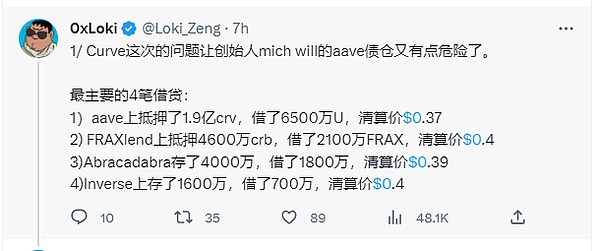
Specifically, Egorov used a large number of CRV tokens (about 141 million US dollars) as collateral to borrow stablecoins from multiple DeFi platforms, mainly crvUSD. Egorov conducted lending operations on multiple platforms such as LlamaLend, Inverse, Uwu Lend and Fraxlend, which have annual interest rates of up to 120%.
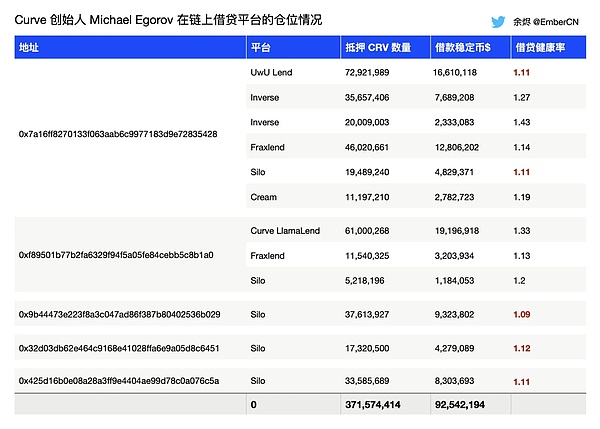
Since the incident, the price of CRV has plummeted by nearly 25% in a short period of time, from $0.35 to $0.21, triggering the liquidation mechanism of multiple platforms.
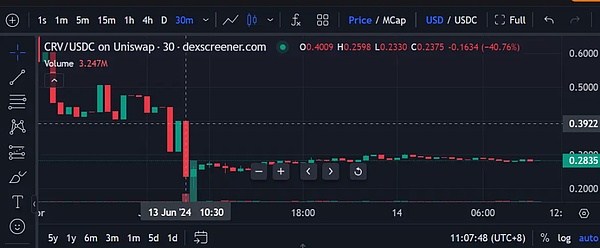
This is not the first time that Michael Egorov has been liquidated. In November 2022, there were big shorts in the market trying to short CRV, which was called the first DeFi defense war. In order to combat this shorting behavior, Curve founder Michael Egorov adopted some short-selling strategies to try to stabilize the price of CRV. Through these strategies, the price of CRV not only did not fall, but rebounded, and Egorov won a phased victory in the fight against the shorts.
The second time was in August last year, when Michael Egorov pledged a total of 292 million CRVs worth $181 million on lending platforms such as Aave, FRAXlend, Abracadabr, and Inverse, and lent out $110 million in funds, with a comprehensive liquidation price of about $0.4.
In last year's liquidation, in order to avoid liquidation caused by the decline in CRV prices, Michael Egorov took the initiative to cover his position and sold 159.4 million CRVs to 33 investors or institutions in an OTC over-the-counter transaction in exchange for 63.76 million stablecoins to repay the loan and save his position.
In addition, in the second round of DeFi defense battles, Egorov also received support from many well-known investors and institutions, including Wu Jihan, Du Jun, and Sun Yuchen, who purchased a large amount of CRV through OTC transactions to help stabilize the market.
However, in response to this year's liquidation storm, although Curve founder Michael Egorov responded on social media that day that the Curve team and himself have been working hard to solve the liquidation risk problem today, as everyone knows, all his loan positions have been liquidated.
Based on this dilemma, Michael Egorov was indifferent in the third round of DeFi defense war, basically doing not to cover positions and not to rescue.
Why can Michael Egorov be so calm? Because he himself "profited" from it.
Regarding the liquidation of CRV positions, Ethereum core developer eric.eth said that the founder of Curve did not suffer "losses" due to the liquidation of CRV. He earned $100 million from a CRV position worth $140 million.
Michael Egorov's profit principle is similar to traditional stock borrowing operations. By using Curve DAO tokens (CRV) as collateral, he borrowed a large amount of loans on multiple DeFi platforms, but here, the collateral is cryptocurrency instead of stocks.
Traditional stock borrowing usually refers to individuals or institutions pledging their stocks to financial institutions in order to obtain loans. This operation can help holders obtain liquidity funds without selling their stocks while continuing to enjoy the potential for stock appreciation.
Although Egorov did not sell his CRV tokens directly, by borrowing them as collateral, he actually realized the conversion of part of the value of the tokens into available liquidity funds. This operation can be seen as a variant of equity cashing out, because he obtained cash flow by pledging tokens instead of selling tokens directly.
Of course, through the calmness of Michael Egorov in the past few days, it is basically certain that he has given up Curve and wants to make a final profit before letting go. Compared with the forced discount method of being acquired, pledging CRV is indeed more profitable for him.
But on the other side, investors are facing a disaster.
The price drop triggered the liquidation of other lending platforms, and Fraxlend's lenders suffered millions of dollars in liquidations. According to Lookonchain monitoring, some users were liquidated on Fraxlend for 10.58 million CRV (US$3.3 million).
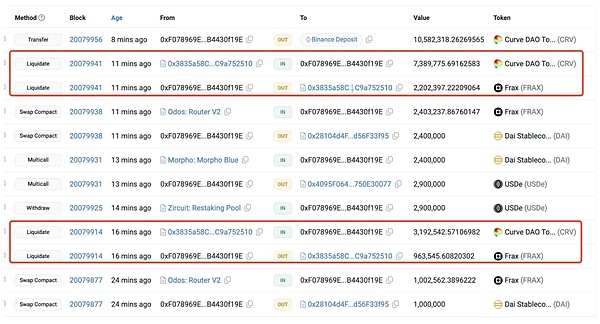
Early CRV investors and other investors in its ecosystem are also facing huge losses. According to DeFiLlama data, as of June 18, Curve's TVL has dropped to $1.9 billion. Compared with the high of $23 billion in 2022, TVL has shrunk to less than one-tenth of the original, and its ranking in the DeFi market has also dropped to outside the top 15.
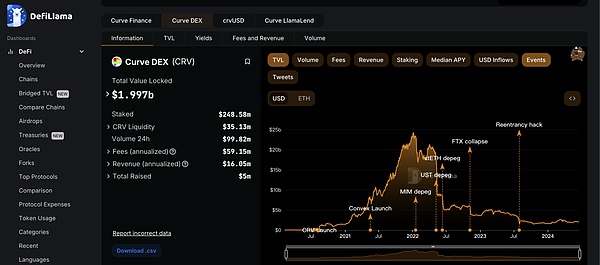
Of course, in the face of this liquidation storm, some people support and profit. For example, Christian, co-founder of the crypto fund NDV and NFT giant, said that he received 30 million CRV from Michael Egorov to support the future of Curve and DeFi. It is reported that Christian bought about 6 million US dollars of CRV off-market, that is, the price of each CRV token is 0.2 US dollars. According to the current price of 0.28 US dollars, the book profit is about 40%.
No matter how the follow-up of this matter goes, judging from the current attitude of the founder Michael Egorov, Curve has no way to go. These two top DeFi products that once ran parallel with Uniswap were ruined by the founder himself, which is really regrettable. Of course, judging from these DeFi defense battles, the development of the DeFi track currently has many shortcomings, and I hope that the project parties will take this as a warning.
 Bitcoinist
Bitcoinist
 Bitcoinist
Bitcoinist Others
Others Others
Others Bitcoinist
Bitcoinist
 Bitcoinist
Bitcoinist Cointelegraph
Cointelegraph Bitcoinist
Bitcoinist Cointelegraph
Cointelegraph Cointelegraph
Cointelegraph